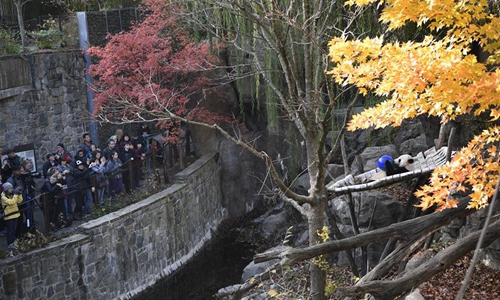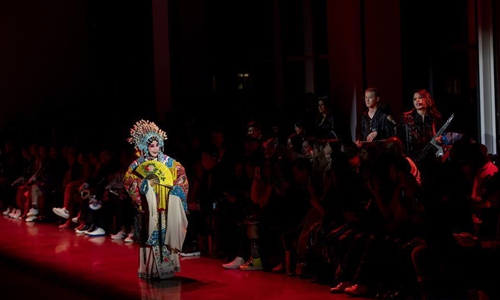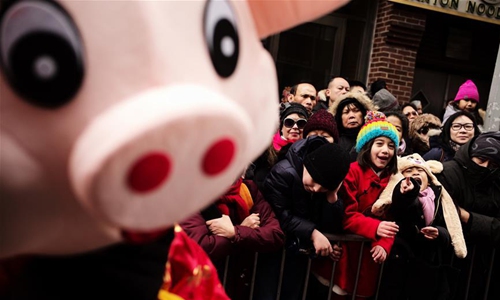Yearender: US-China subnational ties robust in 2019 despite crosscurrents
The orchestra, which pioneered cultural exchanges between the United States and China in 1973, has found its music reaching a larger Chinese audience, not only in concert halls, but also in more private settings, such as classrooms and hospitals.
"We have relationships forged over almost 50 years with the people of China ... that are deeply important to us and we want to continue to develop and nurture those relationships for decades to come," Matias Tarnopolsky, the orchestra's president and CEO, told Xinhua.
The Philadelphia Orchestra story epitomizes the strengthening of people-to-people connections that China and the United States have seen over the past year.
While the bilateral relationship is going through some rough patches at the national level, wide-ranging exchanges and cooperation at the subnational level have not been losing steam.
"No matter what the climate externally is, these collaborations continue," Tarnopolsky said.

Visitors watch the U.S.-born male giant panda Bei Bei at the Smithsonian's National Zoo in Washington D.C., the United States, on Nov. 11, 2019. A weeklong farewell party for Bei Bei, who is to depart the zoo for China later this month, kicked off here on Nov. 11. In 2019, while the bilateral relationship between China and the United States is going through some rough patches at the national level, wide-ranging exchanges and cooperation at the subnational level have not been losing steam. Photo: Xinhua
SISTERSHIPS GO DEEP
As the first US orchestra to tour the People's Republic of China, the Philadelphia Orchestra has served as an ambassador advancing connections between the two countries, and in particular, between the city of Philadelphia and its sister city in China, Tianjin.
In December 1979, shortly after the establishment of China-US diplomatic ties, Philadelphia became one of the first US cities to initiate a sister-city relationship with a Chinese city.
"We are one of the firsts. We honor it. We want to do it well," Samuel K. Chueh, director of international business at the Philadelphia Department of Commerce, said in March. Philadelphia is fully devoted to its Chinese "sister" Tianjin, he added.
Fast forward 40 years, and the two countries now have 277 pairs of sister relationships at different levels, and the momentum is still going strong.
"Sister city relationships touch the hearts and the passions of US and Chinese citizens, [and] because of that these relationships have endured over time," said Roger-Mark De Souza, president of Sister City International (SCI), a non-profit organization that promotes local-level ties between the United States and other countries.
This year has seen a rich variety of activities held across the United States to celebrate these sisterships.
In November, Washington D.C. commemorated the 35th anniversary of its sister-city relationship with Beijing by hosting, among other events, the 2019 Beijing Day Cultural Festival, which showcased some features of the traditional Chinese culture, including paper-cutting, fan-painting and calligraphy.
Muriel Bowser, mayor of Washington D.C., recalled a number of "successes" of the sisterhood, including the refurbishing of the Friendship Arch, a well-known landmark in the US capital's Chinatown neighborhood, the establishment of a D.C. office in Beijing, and collaboration between artists and schools in both cities.
Beijing and Washington D.C. "have developed a strong friendship with each other, and become a role model of sister-city exchanges," said Cui Tiankai, Chinese ambassador to the United States.
Also in November, the southern US city of San Antonio received a six-and-a-half-ton Taihu rock from Wuxi, its sister city in China, as a gift to celebrate their friendship.
Since Wuxi and San Antonio forged a sister-city relationship in 2012, the two cities have witnessed frequent cultural, economic and educational exchanges, said Sun Guoxiang, deputy head of the standing committee of Wuxi municipal people's congress. "This Taihu rock will make our relationship closer," he said.
"The sister-city relationship is an important way to enhance the people's friendship and subnational cooperation. It provides a strong momentum for bilateral relations between the two countries," Cui said.

An artist performs at the "PONY X HARBIN" show during the New York Fashion Week in New York, the United States, Feb. 9, 2019. The show started with a short music piece that was a fusion of Peking Opera and R&B, followed by a catwalk show debuting collection jointly presented by Chinese brand Harbin Beer and American sports brand PONY. In 2019, while the bilateral relationship between China and the United States is going through some rough patches at the national level, wide-ranging exchanges and cooperation at the subnational level have not been losing steam. Photo: Xinhua
FRIENDSHIPS IN THE MAKING
A sister relationship is often forged between entities with similar geographical features or trade opportunities, and is fueled by common local interests. The potential for more twining, or relationships of a similar nature, is huge.
"There are a lot of opportunities because China is so large. It's such a large population. A lot is happening," De Souza said, noting there is equal enthusiasm on both sides.
In 2019, southwest China's city of Chengdu reached out to more US cities, including Austin in the state of Texas and Los Angeles in California. A passion for innovation and technology, among other similarities, brought them closer.
"The cities of Austin and Chengdu have so much in common," Steve Adler, mayor of Austin, said at a March event promoting Chengdu, hailing Austin and Chengdu as "forward-looking cities" and "cities that are technology and innovation centers."
Adler saw ample possibilities for an upgrade of their relations. "Conversations and meetings like this will lead to science city, friendship city kinds of relationship. That is in our future. I think there are going to be lots of different kinds of relationships," he said.
Later in November, Angelenos gathered to celebrate "all things Chengdu" at the 2019 Los Angeles-Chengdu Culture and Innovation Exchange Series Events.
Chengdu has much in common with the "City of Angels" as a center for entertainment, creativity and technology, said Wang Jin, cultural consul of the Chinese Consulate General in Los Angeles.
The event brought to the Southern California city a handsome photo display, stunning traditional handkerchief dancers, delicate Chinese paper cuts, and a duo of jolly panda bear-suited performers.
"On the basis of more and more tourism and cultural exchanges, Chengdu and Los Angeles are working together to further promote cooperation in all fields," said Duoyang Namu, director-general of the Chengdu Municipal Bureau of Culture, Radio, Television and Tourism.
US regions and cities are similarly motivated to promote themselves in China and foster new partnerships. Such platforms as the China International Import Expo (CIIE) have lent a hand.
In November, a delegation of more than 20 business leaders from the Greater Houston area set up booths at the second CIIE in Shanghai to promote the region as an attractive one for business and investment.
"One of the purposes for this mission is to build more trade net (with China)," Jensen Shen, director for Asia, Australia and Oceania at Greater Houston Partnership, which organized the delegation, said before the expo.
Also present at the CIIE were representatives of the small Texas city of Sealy, who hoped their very first trip to China could help bring back "more manufacturing jobs."
"There's real hunger to engage and partner" between China and the United States at local levels, SCI President Roger-Mark De Souza said.

People watch the Chinese Lunar New Year parade in Manhattan's Chinatown of New York City, the United States, Feb. 17, 2019. In 2019, while the bilateral relationship between China and the United States is going through some rough patches at the national level, wide-ranging exchanges and cooperation at the subnational level have not been losing steam. Photo: Xinhua
GETTING CLOSER IN FESTIVE JOY
This year marks the 40th anniversary of the establishment of China-US diplomatic ties. Commemorations of all sorts have been held across the United States throughout the year, many concurrently with celebrations of traditional Chinese festivals.
By getting to know these festivals and engaging in the festivities, many Americans have developed a better understanding of the Chinese culture, traditions and values. People from both sides of the world are thus brought closer together.
The Chinese New Year is without doubt the most important festival to Chinese and has for long been widely celebrated in the United States. This year, it fell on Feb. 5.
On Feb. 6, the New York Philharmonic presented its eighth edition of Lunar New Year concert at Lincoln Center in New York City.
Having celebrated the festival for eight years, the New York Philharmonic intends to "continue it pretty much indefinitely" because both locals and Chinese people here love it, said Bill Thomas, executive director of the orchestra.
About 4,000 km away in the Disney Hall in downtown Los Angeles, Los Angeles Philharmonic staged a concert on the same day, presenting Chinese and Western classics, including the world premiere of a new piece by Shanghai-born, Pulitzer Prize-winning composer, Du Yun.
Du's performance marked the first time in history that Xinchang Diaoqiang opera, a type of traditional Chinese opera, had been heard by an international audience.
"The Chinese New Year program was a big priority for us. US audiences are very open to learning about the culture of China and engaging in the celebration of the Lunar New Year as well," said Megan Martineau, artistic administrator of the LA Phil.
Recent years have also seen some of the previously less well-known Chinese festivals gaining popularity among Americans. A case in point is the Mid-Autumn Festival, which falls on the 15th day of the eighth month of the Chinese lunar calendar. In 2019, it fell on Sept. 13.
In September, for the first time, a premier luxury district in New York City -- Madison Avenue in the Upper East Side of Manhattan -- offered Chinese cultural experiences marking the festival.
Shoppers were offered personalized calligraphy on shoes purchased at Alexandre Birman, onsite Chinese brush painting at Jimmy Choo and footwear customized with special Mandarin characters at Sergio Rossi, to name just a few.
"It was our stores that recognized the importance of expanding cultural events for the Chinese communities and also for the local and other communities that might want to know more about China," said Matthew Bauer, president of the Madison Avenue business improvement district.
"Chinese New Year celebrations have long been a staple here. But from now on, the Mid-Autumn Festival will be a new tradition," Bauer added.
Mid-Autumn festivities featuring lion and dragon dances, concerts, Kung Fu shows and tasting of mooncakes were also held in many other US cities, bringing festive cheer to Chinese and Americans alike.
"Under the current circumstances, it is all the more important that we bring into full play the role of cultural exchanges in deepening mutual understanding and strengthening the friendship between our two peoples," Chinese Consul General in Los Angeles Zhang Ping said during a celebration at South Coast Plaza in Southern California.
"For 40 years, friendship and cooperation have been a keynote of China-US relations. There is a lasting driving force for our relations to move forward," Chinese Ambassador to the United States Cui Tiankai said.
It is hoped that "positive factors at local levels will triumph over the negatives in certain areas," Cui noted.